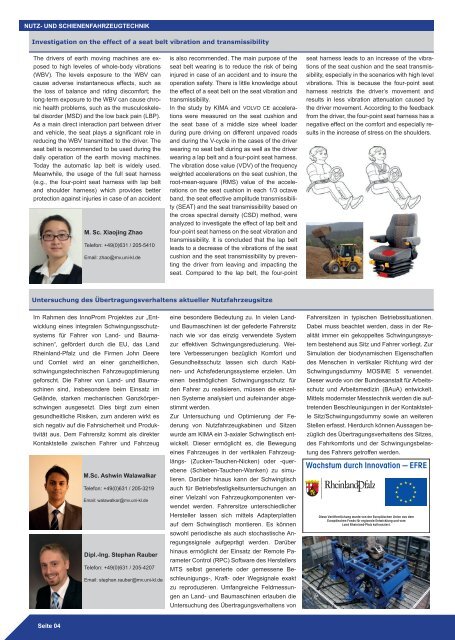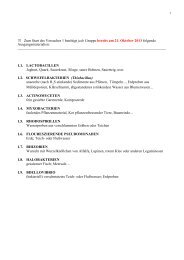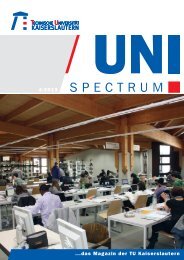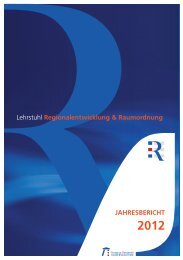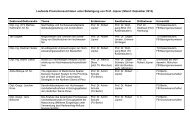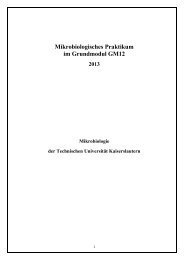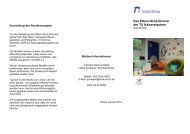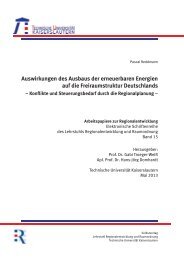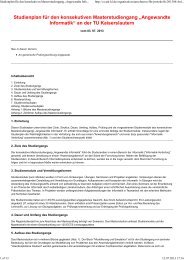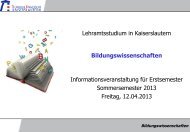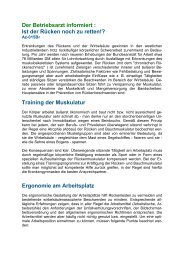KIMA Insight - Universität Kaiserslautern
KIMA Insight - Universität Kaiserslautern
KIMA Insight - Universität Kaiserslautern
Sie wollen auch ein ePaper? Erhöhen Sie die Reichweite Ihrer Titel.
YUMPU macht aus Druck-PDFs automatisch weboptimierte ePaper, die Google liebt.
NUTZ- UND SCHIENENFAHRZEUGTECHNIK<br />
Investigation on the effect of a seat belt vibration and transmissibility<br />
The drivers of earth moving machines are exposed<br />
to high leveles of whole-body vibrations<br />
(WBV). The levels exposure to the WBV can<br />
cause adverse instantaneous effects, such as<br />
the loss of balance and riding discomfort; the<br />
long-term exposure to the WBV can cause chronic<br />
health problems, such as the musculoskeletal<br />
disorder (MSD) and the low back pain (LBP).<br />
As a main direct interaction part between driver<br />
and vehicle, the seat plays a significant role in<br />
reducing the WBV transmitted to the driver. The<br />
seat belt is recommended to be used during the<br />
daily operation of the earth moving machines.<br />
Today the automatic lap belt is widely used.<br />
Meanwhile, the usage of the full seat harness<br />
(e.g., the four-point seat harness with lap belt<br />
and shoulder harness) which provides better<br />
protection against injuries in case of an accident<br />
M. Sc. Xiaojing Zhao<br />
Telefon: +49(0)631 / 205-5410<br />
Email: zhao@mv.uni-kl.de<br />
is also recommended. The main purpose of the<br />
seat belt wearing is to reduce the risk of being<br />
injured in case of an accident and to insure the<br />
operation safety. There is little knowledge about<br />
the effect of a seat belt on the seat vibration and<br />
transmissibility.<br />
In the study by <strong>KIMA</strong> and VOLVO CE accelerations<br />
were measured on the seat cushion and<br />
the seat base of a middle size wheel loader<br />
during pure driving on different unpaved roads<br />
and during the V-cycle in the cases of the driver<br />
wearing no seat belt during as well as the driver<br />
wearing a lap belt and a four-point seat harness.<br />
The vibration dose value (VDV) of the frequency<br />
weighted accelerations on the seat cushion, the<br />
root-mean-square (RMS) value of the accelerations<br />
on the seat cushion in each 1/3 octave<br />
band, the seat effective amplitude transmissibility<br />
(SEAT) and the seat transmissibility based on<br />
the cross spectral density (CSD) method, were<br />
analyzed to investigate the effect of lap belt and<br />
four-point seat harness on the seat vibration and<br />
transmissibility. It is concluded that the lap belt<br />
leads to a decrease of the vibrations of the seat<br />
cushion and the seat transmissibility by preventing<br />
the driver from leaving and impacting the<br />
seat. Compared to the lap belt, the four-point<br />
seat harness leads to an increase of the vibrations<br />
of the seat cushion and the seat transmissibility,<br />
especially in the scenarios with high level<br />
vibrations. This is because the four-point seat<br />
harness restricts the driver’s movement and<br />
results in less vibration attenuation caused by<br />
the driver movement. According to the feedback<br />
from the driver, the four-point seat harness has a<br />
negative effect on the comfort and especially results<br />
in the increase of stress on the shoulders.<br />
Untersuchung des Übertragungsverhaltens aktueller Nutzfahrzeugsitze<br />
Im Rahmen des InnoProm Projektes zur „Entwicklung<br />
eines integralen Schwingungsschutzsystems<br />
für Fahrer von Land- und Baumaschinen“,<br />
gefördert durch die EU, das Land<br />
Rheinland-Pfalz und die Firmen John Deere<br />
und Comlet wird an einer ganzheitlichen,<br />
schwingungstechnischen Fahrzeugoptimierung<br />
geforscht. Die Fahrer von Land- und Baumaschinen<br />
sind, insbesondere beim Einsatz im<br />
Gelände, starken mechanischen Ganzkörperschwingen<br />
ausgesetzt. Dies birgt zum einen<br />
gesundheitliche Risiken, zum anderen wirkt es<br />
sich negativ auf die Fahrsicherheit und Produktivität<br />
aus. Dem Fahrersitz kommt als direkter<br />
Kontaktstelle zwischen Fahrer und Fahrzeug<br />
M.Sc. Ashwin Walawalkar<br />
Telefon: +49(0)631 / 205-3219<br />
Email: walawalkar@mv.uni-kl.de<br />
Dipl.-Ing. Stephan Rauber<br />
Telefon: +49(0)631 / 205-4207<br />
Email: stephan.rauber@mv.uni-kl.de<br />
eine besondere Bedeutung zu. In vielen Landund<br />
Baumaschinen ist der gefederte Fahrersitz<br />
nach wie vor das einzig verwendete System<br />
zur effektiven Schwingungsreduzierung. Weitere<br />
Verbesserungen bezüglich Komfort und<br />
Gesundheitsschutz lassen sich durch Kabinen-<br />
und Achsfederungssysteme erzielen. Um<br />
einen bestmöglichen Schwingungsschutz für<br />
den Fahrer zu realisieren, müssen die einzelnen<br />
Systeme analysiert und aufeinander abgestimmt<br />
werden.<br />
Zur Untersuchung und Optimierung der Federung<br />
von Nutzfahrzeugkabinen und Sitzen<br />
wurde am <strong>KIMA</strong> ein 3-axialer Schwingtisch entwickelt.<br />
Dieser ermöglicht es, die Bewegung<br />
eines Fahrzeuges in der vertikalen Fahrzeuglängs-<br />
(Zucken-Tauchen-Nicken) oder -querebene<br />
(Schieben-Tauchen-Wanken) zu simulieren.<br />
Darüber hinaus kann der Schwingtisch<br />
auch für Betriebsfestigkeitsuntersuchungen an<br />
einer Vielzahl von Fahrzeugkomponenten verwendet<br />
werden. Fahrersitze unterschiedlicher<br />
Hersteller lassen sich mittels Adapterplatten<br />
auf dem Schwingtisch montieren. Es können<br />
sowohl periodische als auch stochastische Anregungssignale<br />
aufgeprägt werden. Darüber<br />
hinaus ermöglicht der Einsatz der Remote Parameter<br />
Control (RPC) Software des Herstellers<br />
MTS selbst generierte oder gemessene Beschleunigungs-,<br />
Kraft- oder Wegsignale exakt<br />
zu reproduzieren. Umfangreiche Feldmessungen<br />
an Land- und Baumaschinen erlauben die<br />
Untersuchung des Übertragungsverhaltens von<br />
Fahrersitzen in typischen Betriebssituationen.<br />
Dabei muss beachtet werden, dass in der Realität<br />
immer ein gekoppeltes Schwingungssystem<br />
bestehend aus Sitz und Fahrer vorliegt. Zur<br />
Simulation der biodynamischen Eigenschaften<br />
des Menschen in vertikaler Richtung wird der<br />
Schwingungsdummy MOSIME 5 verwendet.<br />
Dieser wurde von der Bundesanstalt für Arbeitsschutz<br />
und Arbeitsmedizin (BAuA) entwickelt.<br />
Mittels modernster Messtechnik werden die auftretenden<br />
Beschleunigungen in der Kontaktstelle<br />
Sitz/Schwingungsdummy sowie an weiteren<br />
Stellen erfasst. Hierdurch können Aussagen bezüglich<br />
des Übertragungsverhaltens des Sitzes,<br />
des Fahrkomforts und der Schwingungsbelastung<br />
des Fahrers getroffen werden.<br />
Seite 04


